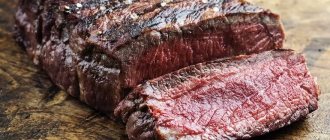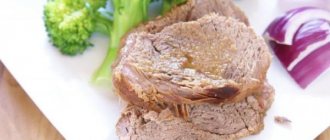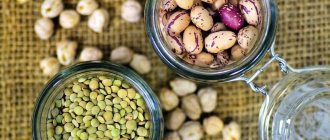Primitive people, roasting meat over a fire, did not imagine that they were at the origins of the steak culture, because in those days it was the only way to prepare meat. Later, the priests of Ancient Rome offered thick pieces of meat to the gods in the ritual of sacrifice, fried on both sides on a grill right in the temple. However, the first recipe for meat steak, officially published in a cookbook, was born in Great Britain in the 15th century, and soon all of Europe was frying steaks in different versions, depending on the culinary traditions of different countries. After Columbus brought cattle with high-quality meat to America, steaks began to be cooked on the American continent, and in a short time this dish became part of the national cuisine of the New World. It was in America that cooking steaks turned into a real art, and every American chef knows how to deliciously fry a steak. There are certain subtleties that relate to the choice of meat and various culinary techniques of frying, knowledge of which will help in mastering this virtuoso art. So, let's try to cook meat steak at home!
What types of steaks are there?
There are many types of steaks. For example, a thick piece of boneless beef, with a layer of fat, cut from the rib part is a ribeye, and a thin layer of boneless meat from the back is a striploin, which has an almost triangular shape. New York steak is similar to striploin, but has no fat. Portehouse is the largest steak from the lumbar region, and filet mignon is the most expensive, juicy, tender and tasty steak from the only round muscle in the body of a bull. T-bone steak is T-shaped meat on the bone and combines two types of meat - fillet and thin edge. "Angleterre" is prepared from the meat from the inside of the shoulder blade, and "Cafe de Paris" steak is made from a piece of the softest meat from the shoulder blade. Quasimodo steak is cut from the lumbar region of the back, and Montevideo is a rump steak. Round steak is prepared from the upper part of the hip region, club steak is prepared from the thick edge of the back, sirloin is prepared from the thigh part of the carcass, and rum steak is a very thin and well-cut tenderloin. As they say, choose a steak to suit your taste!
Dorsal part of the carcass
The thick end is a prestigious piece of carcass, the back closest to the shoulder blade, from which the most popular premium steaks are cut. It consists of muscles that bear minimal load during the life of the bull, so the fibers here are soft and tender, and the fat layers, melting over the fire, give the meat an exquisite taste. the ribeye steak genre , which is cut from the 6th to the 12th rib and must be at least 2.5-3 cm thick.
ribeye steak Ribeye on the cut bone is often called a cowboy steak, and on a trimmed whole rib, a tomahawk. Ribeye is a convenient steak to eat at home and is easy to prepare: sear each side and sides of the steak in a very hot pan, and then cook to desired doneness over moderate heat or in the oven.
The thin edge is the thin part of the lumbar part of the steer's back. It is soft, with delicate fibers. Suitable for quick frying of steaks and grilling. The main premium steak made from this cut is called striploin . Juicy, marbled, but less fatty than ribeye. It has a concentrated meaty taste. The fat layer located along the edge of the piece is sometimes cut off before frying, sometimes it is left so that it soaks the meat in juice, and is cut off when serving. It is recommended to serve the steak half-done: medium rare or medium.
chateaubriand steak
Tenderloin is the leanest and most delicate back cut, almost devoid of fat. The central part of the tenderloin is used for classic steaks filet mignon and chateaubriand . When frying, it is easy to dry out the tenderloin, so the best option for it is to minimally fry the gage. Carpaccio and tartare, where the meat is served raw, are also the prerogatives of the tenderloin. Filet mignon
Steak is made only from beef
The most important rule for cooking steaks is choosing the right meat. Initially, steaks were prepared from beef, so if they say “steak”, they mean a beef dish. For other meats, clarification is required, so in this case they write: pork steak, chicken, salmon, and so on. But true steak connoisseurs say that steaks made from any meat other than beef are not steaks.
Naturally, the beef needs to be selected - it is believed that for the perfect steak you should take the meat of young bulls aged 1–1.5 years of the Hereford, Shorthorn, Angus and Longhorn breeds, fed on grass, wheat and corn. Bulls that grew up on grain crops, and not just grazed the grass on the lawn, acquire an unusually tender fat layer, evenly distributed in the piece. This is how elite marbled beef is obtained, from which the best steaks in the world are prepared. It is interesting that for classic steaks they take mainly bull meat, and the same dish prepared from cow meat is called beefsteak.
How to choose steak meat
The method of cutting the carcass is also important, since for steaks it is better to take meat fibers cut crosswise, 2.5–4 cm thick. This cutting allows the oil to penetrate the pores of the meat pulp, so the steaks cook quickly and turn out more juicy. By and large, only up to 10% of the carcass is suitable for steaks, so the meat intended for this dish is considered elite and expensive. The back muscles are most suitable for steaks - the fact is that pieces from areas of the body where the muscles are at rest are better cooked and soft. It doesn’t matter whether the meat is on the bone or without it, the main thing is that the piece is complete and you don’t have to cut off unnecessary pieces of fat or sinew from it. And the meat should be fresh, dry, rich dark in color, with a smooth and silky surface. They say that the most delicious steaks come from lightly dried meat. The most important thing is that the meat is not steamed, otherwise the steak will turn out tough, and its taste, which is precisely what fermentation provides, will not be so rich and rich.
Original side dishes for steaks
If you are already tired of potatoes and grilled vegetables and your stomach is asking for something more, then here is a list of more interesting side dishes for steak:
- Vegetable puree. Instead of potatoes, this dish uses various vegetables, such as green peas, celery or carrots.
- Caramelized onions. It can be used both as a side dish and as a sauce. But to get a truly tasty dish, it is recommended to use pearl onions.
- Green side dish. It is prepared from asparagus and green beans by grilling them. You can also add bacon.
Of course, there are still a lot of different side dishes that will not only perfectly complement the taste of the steak, but will also give you a completely new gastronomic experience, so don’t be afraid to experiment and try something new!
Preparing meat for frying
About an hour before cooking, remove the meat from the refrigerator to allow it to come to room temperature. This is necessary for even cooking of the steak. If you cook frozen steaks, you should put them out of the freezer in the refrigerator in the evening so that they thaw gradually. But experts say that steaks made from previously frozen meat lose a lot in taste.
Some housewives marinate steaks in lemon juice with salt and spices for softness and juiciness, although the choice of marinade is a matter of taste. Before frying, pieces of meat should be coated with olive oil and pepper, but when to salt the meat is a controversial issue. Some argue that you need to salt before frying, while others are sure that it is more correct to salt after the golden brown crust appears, and even better - already on the plate. How best to make it is up to you, in accordance with your personal taste preferences.
The most popular side dishes for beef steak
You should immediately understand that the main task of the side dish is to emphasize the taste of the steak, and not to interrupt or drown it out. It’s not for nothing that the word “garnish” itself translated from French means decoration. This name perfectly characterizes the functional purpose of this element of the dish.
It is also worth noting that some types of side dishes play a more important role than a simple addition - they can facilitate the digestion of meat or take on a certain amount of fat.
So, the first and most universal type of side dish for marbled beef is potatoes. Moreover, it can be served in any form - fried, baked, as a puree, etc. It has a mild enough flavor that it won't overwhelm the taste of the steak. The main thing is not to overdo it with seasonings. It’s better to limit yourself to salt and olive oil.
Both professional chefs and ordinary barbecue lovers agree that the best side dish for meat is a salad of fresh vegetables and herbs. Firstly, this is due to their unobtrusive taste, and secondly, their ability to increase the production of digestive enzymes, which simplify the absorption of beef by the body.
Another equally popular type of side dish is grilled vegetables. They are easy and quick to prepare, do not require any special preparation and perfectly complement the taste of steak. Simply grease the ingredients with oil, add salt and place on the grill.
What kind of vessel is used to cook steak?
You can cook a steak quickly and tasty in the oven, Josper charcoal grill oven, on an open grill and in a grill pan, in which the meat does not burn and acquires an appetizing pattern. The fat, flowing into the hollows of the pan, is not absorbed into the meat, and the dish turns out to be dietary. But after the oven, the meat is always juicier and softer, because it is cooked not only thanks to the high temperature emanating from a metal dish or grill, but also thanks to the enveloping heat. If you use a regular frying pan, it should be with a thick bottom, although it is believed that steak should not be cooked in regular frying pans or in a slow cooker - only a grill is suitable for this purpose.
The grill pan or oven should be as hot as possible before frying begins, and both butter and vegetable oil can be used. However, if you use butter, you shouldn’t get the pan too hot. In this regard, frying in vegetable oil has its advantages, since it has a higher combustion temperature. Some cooks mix the two types of butter for best results, but the ideal option is to cook steaks in ghee, which does not burn and has a mild flavor. By the way, ribeye steak, which is universal, is most suitable for frying in a frying pan. The fat layer in the meat pulp quickly melts, soaking the steak and making it very juicy, tender and tasty.
Back of the carcass
Rump is a piece of boneless flesh from the inner part of the thigh. Most of the cut is quite coarse and fibrous, but has a very strong flavor. Suitable for stewing and slow baking. The rump produces strong and light broths and minced meat for kebabs and burgers.
Rump is the upper part of the hip cut. Most often, rump is used to prepare high-quality roast beef . This meat works great in kebabs. Several steaks are cut from the rump. The most popular of them is sirloin . The meat is quite soft, but at the same time textured, with pronounced fibers. Sirloin is suitable for baking in the oven in a large piece with herbs, for frying in a pan in the form of steaks, and thinly sliced for beef stroganoff. Rump steak from the back of the rump is full of meaty flavor, but at the same time tough. Before frying or baking, it is better to soften it with marinade.
Picanha - cut from the hip part of the carcass at the junction of the lumbar and sacral regions. The cut is especially popular in Latin America. This is the best meat for grilling: picanha is valued for its delicate textured flesh, “packed” in a cuff of fat, which, when fried on a grill or spit, melts and saturates the meat with juice. Typically, picanha is cooked over the fire in one large piece or cut into slices and placed on skewers in a folded form.
Sirloin – lean meat from the hip cut. The sirloin has a rather loose texture, it is suitable for baking in the oven in large pieces, it can also be cut across the grain into portions and beaten for frying steaks or rump steaks .
The eye muscle is a separate muscle that stands out from the back of the carcass. Also known as the “round eye” or “bull’s eye”. It has an oblong round shape. There is practically no fat in this cut, the fibers of the pulp are elastic, it has texture and aroma; such meat is best used in stews, for example, in stews with vegetables. A large piece of roasted cut makes an excellent base for sandwiches. You can also make a beefsteak from the “apple” - thinly slice it across the grain and beat it well.
Spider Steak is one of the smallest steaks. The spider steak is tightly adjacent to the hip joint, so only a very experienced butcher can remove it without damaging it. This muscle is practically not loaded, so the steak turns out soft. Has a slight “liver” taste. The steak got its name “spider” due to the fatty mesh that resembles a spider’s web.
Merlot steak is perhaps the most secret steak in the entire beef carcass. This muscle is tucked away in the tough part of the back cut, just above the Achilles tendon, and yet has such vibrancy and tenderness that it is suitable for pan-searing, like premium steaks, and for tartare. Shank . The most valuable steak from this part of the beef is called osso buco . This is a cross cut on the sugar bone, its fleshiest part. Suitable for long-term stewing. An Italian classic of the osso buco genre, stewed in white wine and broth with vegetables.
How to cook a delicious steak: fry quickly
The main rule for cooking steak is to first fry it very quickly in a hot frying pan until crusty, and then bring it to readiness over lower heat. The fact is that the protein coagulates under the influence of high temperature and prevents the juice from leaking out of the meat. Before frying, some cooks dry the steak for an hour in the oven at a temperature of 60 ° C, since dried meat instantly gives a dense golden brown crust when fried. If you neglect this rule, the steak will turn out dry and tough. At the same time, do not forget to also fry the side edges of the steak, holding it with meat tongs for convenience. A steak covered on all sides with a thick crust will be perfectly cooked and remain juicy. This is one of the main tricks to cooking steak. Don't overheat the pan to the point where it starts to smoke, because if the steak burns, you won't be able to continue frying and it will turn out raw.
Question answer
Answered by Vlad Piskunov, Chef of the virtual restaurant “Mangiare e Bere”, TV presenter of the “Kitchen TV” channel, famous culinary blogger
What kind of beef is good for steak?
— Marbled Australian beef is best for steak. You can either buy a whole cut and cut it yourself, or purchase steaks already cut.
Should steaks be marinated?
— You can prepare a seasoning from salt, water, spices, lemon juice and rosemary. Baste the steaks directly on the grill.
Which steak is best for pan frying?
— Ribeye steak is best suited for cooking in a frying pan. It's universal. The name comes from two English words rib-eye, i.e. "rib" and "eye". The rib is where the cut comes from, and the eye is the cross-cut shape that ribeye steaks inherit. The abundance of fatty layers (the very marbling of the meat) quickly melts when frying, making Ribeye the juiciest and most unpretentious to cook of all steaks.
How long to fry a steak, how to turn it over
A steak approximately 3 cm thick is fried on each side for 4–5 minutes, and if you have pieces of meat of a different size, then add or subtract one minute for each centimeter. How to cook steak correctly - turn it often or rarely? This is one of the most common questions novice cooks ask. There are two options here - either turn over every 30 seconds (of course, after the initial frying), or change the position of the steak no more than 4 times during the entire time. In the first case, you will get an evenly fried and not overdried steak; in the second case, the steak will turn out very beautiful, with a pattern from the grill pan or grate.
Cutting pieces across the grain also helps a lot in frying. Heat flows through the meat, continuing to heat it even after the steak is removed from the heat. That is why there is no need to fry the steak for a long time - it will be ready on your plate. However, if you are afraid to serve raw meat, cook the steak for about 15 minutes, but no more, so that the beef does not lose tenderness and juiciness.
Determining the degree of cooking of the steak
There are six degrees of doneness, the choice of which depends solely on your personal tastes. When frying blue, the steak comes out with blood, while rar is a very lightly fried steak, but without blood. Medium rare steak is lightly fried meat: there is a crust on the outside, the meat is only heated inside. Medium steak - medium doneness, when the meat is pink in the middle, but still damp. Medium well steak - perfectly cooked, with pinkish meat and well done - a very well done steak, perfectly cooked.
Experienced chefs can determine the degree of doneness visually, but this method requires a lot of experience and skill. You can do it easier - lightly cut the meat and look at its color inside, or press the piece with your finger - a raw steak is usually soft, and the finished piece becomes firm and dense. If you don’t trust your feelings, you can cook according to time - a rare steak is fried for 2 minutes on each side, for lightly done it takes 2.5 minutes, for medium doneness it takes 3 minutes, and a perfectly done steak requires 4.5 minutes. each side.
If you have a needle thermometer, the task is easier - just measure the temperature of the steak to understand what stage of cooking the meat is at. Blue steak is ready at a temperature of 46–49 °C, rar — at 52–55 °C, medium rare — at 55–60 °C, medium — at 60–65 °C, medium well — at 65–69 °C, well done - at 71–100 °C. If the meat is heated above 100°C, the steak is overcooked.
We determine with our own hands
The degree of roasting of a steak can be approximately determined by first poking a finger into the meat, and then with a finger into the palm of the other hand.
The hand is relaxed, the muscle at the base of the thumb too - it will feel like raw meat, in steaks it is blue, with blood.
Touch the tip of your index finger with the tip of your thumb - the muscle has tensed, its hardness resembles rare .
By connecting the thumb and middle fingers, we get a sensation similar to a medium rare .
When the thumb touches the ring finger, the same muscle will be similar in density and elasticity to a medium or medium-done steak.
The joined thumb and little finger will cause the same muscle to turn into something like a well done steak.
Attention! Biting your hand during testing is strongly discouraged!
"Relaxation" and steak tasting
An important secret to cooking a steak is to let it “rest” and recover after intense frying. To do this, place a piece of butter on the steak, cover it loosely with foil and leave for 10 minutes. The longer the steak “rests,” the tastier, more aromatic and more tender it will be. Do not rush to taste, because when frying, the meat fibers tense and slightly compress, but gradually they relax, and the juice is evenly distributed inside the steak. In other words, meat that has “rested” after cooking is always softer than meat that has just been removed from the heat. The steak can be served whole or cut into slices, on a warm plate with any sauce, fried vegetables cooked in the same pan, with fried potatoes, vegetable salad and herbs.
Steak marinated with tequila and lime
This Latin American steak will add variety to your daily diet and lift your spirits. Make a marinade from 3 tbsp. l. tequila, 3 tbsp. l. olive oil, 2 tbsp. l. lime juice, 2 drops of Tabasco sauce, 4 finely chopped cloves of garlic and 1 small onion. Marinate the beef steaks for 2 hours, after placing the dishes with the marinade in the refrigerator, and after 1 hour the meat should be turned over.
Half an hour before the start of frying, turn on the grill, remove the steaks from the marinade, dry them well, rub with pepper and salt. Fry the steaks for 3-4 minutes on each side and let them rest for 10 minutes, then cut the pieces across the grain into thin slices.
The website “Eat at Home” publishes various recipes for meat steaks with photos and step-by-step instructions. When you master the art of cooking meat steaks, you will learn how to select beef at the market, and determine the degree of doneness of the meat by eye. Of course, there is a lot to learn before this moment, but the simplest recipes can be mastered now, delighting your loved ones with tender and juicy steaks, which make life seem more fun and tastier.










